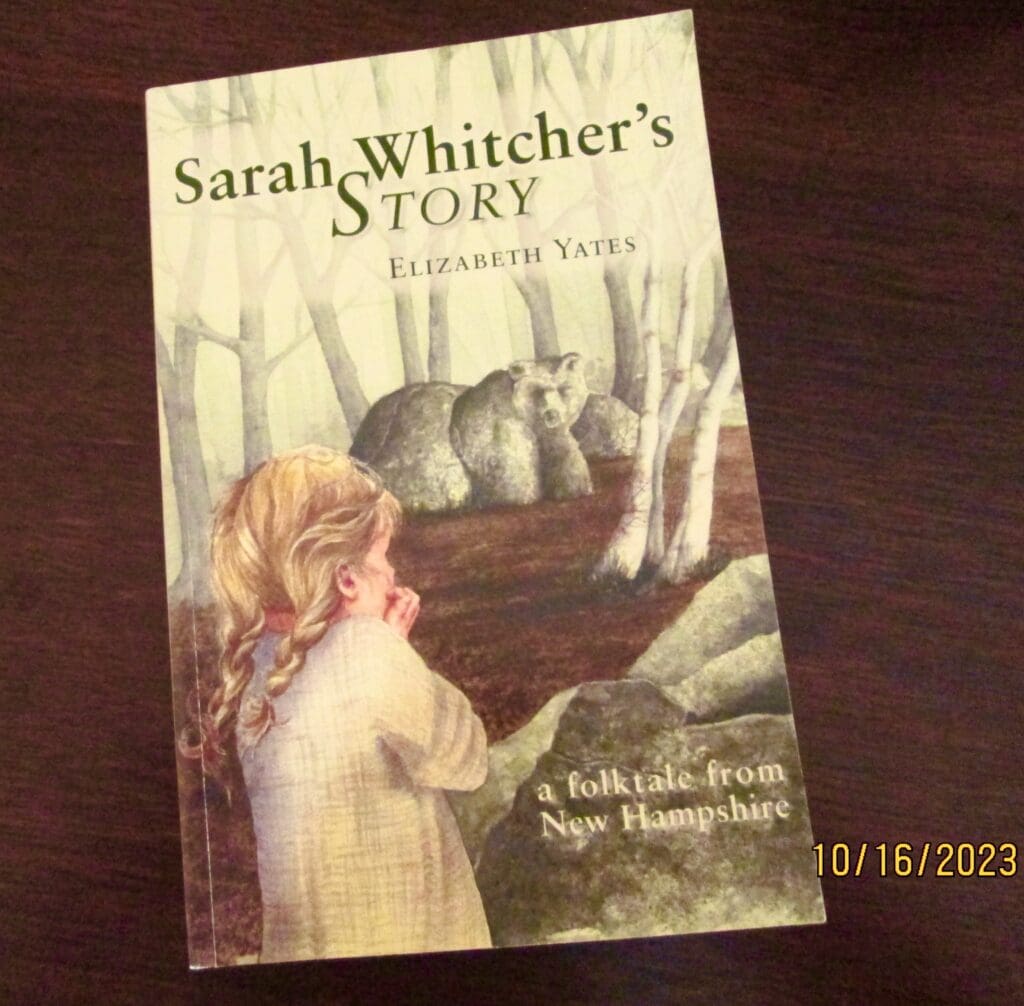
Sarah Whitcher’s Story, by Elizabeth Yates, is listed on the cover as a folktale from New Hampshire. A folktale is a story passed down through the years by word of mouth. They may have a bit of truth in them, or be more like a fairy tale. They are passed down as fun or scary stories told around campfires, or to teach a lesson.
As I began to read the book, I became overly absorbed in trying to figure out whose point of view the story was being told in. By chapter two, I was completely involved in the story and no longer cared about the point of view.
The setting is June 1783, when four-year-old Sarah is left behind with her older brothers and sister in charge of her. The parents travel uphill behind their house a short distance, to spend the afternoon with Sarah’s uncle. The story that follows has become a historical folktale and Elizabeth Yates has told it well. That day, Sarah wanders away from her home and is lost in the woods.
The story flips back and forth between what is happening at home with the family and the neighbors who join in the search, and what is happening with Sarah. Sarah’s dad is pictured as a strong man of faith in God, and her mother stands firm in believing that God will help them find Sarah. On day three, when the neighborhood men are close to giving up the search because no signs of the child have been found, small human footprints are discovered near a stream. Bear footprints are imbedded in the moist earth beside them. (pp. 37-38)
The neighbors, who have left their chores for three days, and depend on completing those chores for their survival, decide there is no more hope and leave for home. Sarah’s mother stops them with these words, “…for the love you bear your own little ones, help us to find our child.” (p.41)
The men agree to come back for one more day of searching.
On page 53 we find Sarah eating the “tender tips of new growth” on a hemlock tree, to fill her hungry stomach. Since hemlock is considered deadly poisonous, I had to look that one up. The author had her facts straight. There is actually an Eastern Hemlock that is an edible evergreen tree that is not related to the poisonous hemlock except by name.
On the fourth day, all of Sarah’s family except for the oldest daughter who stayed behind with kind neighborhood women, went back out to search for Sarah. The women were cooking a large pot of beans to feed the ones who were searching, when a young, thin, and hungry man, Mr. Heath, shows up and says he dreamed a dream about Sarah and where she would be found. He dreamed it three times and had walked from Plymouth to find her (pp. 72-74).
And that’s where I’ll end the story.
Is it true?
Did they find Sarah?
Was Sarah harmed by a bear?
The author has a note at the end of the book on the history of the story. Elizabeth Yates read many books of the period to write about Sarah’s life with accuracy. Descendants of Sarah’s family contacted the author after the book was published.
It is a fascinating story about the faith of the early settlers and God’s help in times of need. It is written for ages 7-9, boys or girls. I highly recommend the book for any age if you like history and are inspired by others who are strong believers in God and His grace, mercy, and kindness.
I’ll end this post with a prayer that the dad prayed over their food in chapter one:
“We’re thankful Lord, for all the good things you’ve given us, and we’ll eat this food to grow strong in your service. Amen.” (p. 3)
And that is one of the most important lesson for us all to learn from childhood throughout life—to grow strong in service for God, taught through the pages of children’s historical fiction.

We absolutely loved this one. Because of the multiple points of view, I think it felt more like a movie in its pacing, and I think that’s why it was hard to put it down. We also read The Bear Who Heard Crying which is a picture book adaptation of this story from the bear’s perspective, so that was fun to hear from all sides, even a bear’s. ha ha
I would love to hear the Bear’s perspective, LOL. The writer of that had to have a great imagination! I’ll have to look for that book at the library:)
Great review. Thank you, Jane.
Thanks for reading and commenting, Tim:)
Thanks for sharing all of the reviews, Jane. I know many people are grateful.
Thanks, Joni.